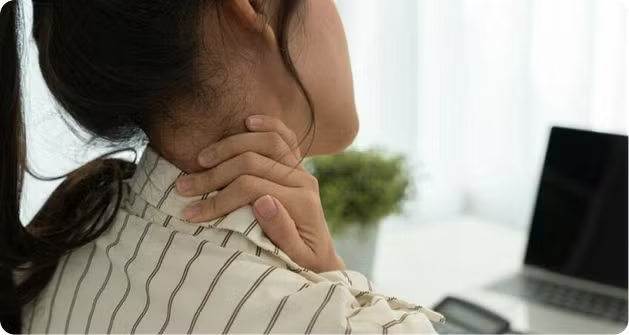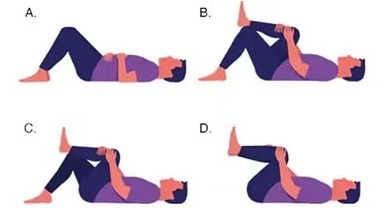
Upper back pain is often correlated with poor posture, and is a common medical problem that affects many populations, especially those who spend long hours sitting in offices or home or using mobile phones. The upper back is also known as thoracic spine range from the neck to the lower ribs and is important to provide support.
It is necessary to understand the relation between poor posture and upper back is crucial for effective treatments.
However, temporary relief can be obtained with therapies like –
- Strengthening exercises
- Lifestyle modification
- Ergonomic practices
- Stretching
- Heat and cold applications
How does poor posture cause upper back pain?
Poor posture is the significant factor in upper back pain because postural misalignments place undue pressure on the ligaments, joints, and muscles which can lead to severe pain and discomfort.
Whenever the spine is not aligned, some muscles become stretched, weak, and tight, this disturbance causes muscle stiffness, fatigue, and pain in the upper back. On the same hand, poor posture can also put pressure on the spinal discs, which increase the chances of degeneration and nerve irritation.
Individual can improve body posture through the help of ergonomic adjustments, home remedies, and core muscle strengthening exercises.
What are the best exercises to fix upper back pain from bad posture?
Fixing upper back pain is crucial with exercises that help in strengthening core muscles of the thoracic spine and improve spinal alignment.
Here are some stretching exercises:
- Bridge exercise
- Lower back rotational stretch
- Knee to chest stretch



How long does it take to correct posture related back pain?
Mild Pain (Short term posture misalignment) - Upper back pain comes from slouching for a few hours and pain is light, then in this case recovery is quick. By maintaining correct posture, doing stretches, and applying hot pads on the affected area of pain, people can feel better in a few days.
Constant Pain (Moderate postural damage) - If back pain lasts for 2 weeks or months through improper posture, this needs more attention. In this daily stretching and using ergonomic chairs while doing office work is essential to ease the pain. It takes a few weeks with constant effort to see the result.
Severe Pain (Chronic upper back pain) - This is caused by long term bad posture or conditions like kyphosis and takes months to improve. This condition needs physical therapy and medical treatments.
Correcting improper body posture which causes back pain takes time to recover, and results vary from patient to patient because some people feel relaxed within weeks, but some may take months.
It is important to manage correction of body posture as long term aim for lasting results.
Can bad posture lead to Upper Back Pain?
Yes, ergonomic chairs are effective in reducing upper back pain by promoting correct posture of the body and support sitting habits dynamically.
Key points of using Ergonomic Chairs:
Protects body posture - These chairs are specially designed to support the natural curve of the spine by maintaining proper posture. These chairs help to alleviate the strain on the upper back, which can cause pain and discomfort.
Support to the spine - These chairs have adjustable backrests, lumbar support, and headrests, which helps the user's body to rest properly. It can minimize pressure points that can lead to severe pain.
Dynamic sitting arrangement - This is the key benefit of these chairs which promote easy movements.
So overall, Using an ergonomic chair in a daily office routine can be beneficial in preventing upper back pain.
Do posture correctors work for upper back pain?
WIth many people across the globe working at office desks on a daily basis- maintaining a good posture is quite essential.
Posture correctors are the temporary wearable devices that give supportive as well as protective effects thereby facilitating a good spinal support.
Posture correctors are intended to alleviate incorrect posture by offering support to the shoulder and upper back. The main primary function is to gently pull the shoulders and align the spine.
However, this device gives temporary aid, just to remind people to maintain correct posture. While this is useful, dependency may lead to muscle reliance, where the muscles support body posture.
Conclusion
Incorrect posture has always taken a toll on the well being of the body. Whether it be with pain, inflammatory condition, difficulty in sitting/ walking/ standing without discomfort. Thereby, it is requisite for us to initiate measures just to maintain it.
Understanding the interlink between the inaccurate posture and upper back pain is required to personalise and command a more suitable treatment plan for better prognosis and recovery.
Correcting your posture, doing regular stretches, resting can contribute effectively to cure your upper back pain.
Back Pain Research References
- The Science of Ergonomics: Keeping Caregivers and Patients Safe. (2025). Cleveland Clinic. https://my.clevelandclinic.org/podcasts/nurse-essentials/the-science-of-ergonomics-keeping-caregivers-and-patients-safe
- Harvard Health Publishing. (2014, March 9). Posture and back health - Harvard Health. Harvard Health; Harvard Health. https://www.health.harvard.edu/pain/posture-and-back-health
- Mayo Clinic. (2023, August 25). Exercises to improve your core strength. Mayo Clinic. https://www.mayoclinic.org/healthy-lifestyle/fitness/in-depth/core-strength/art-20546851
- Upper Back Pain: What it is, Causes, How it Feels & Treatment. (n.d.). Cleveland Clinic. https://my.clevelandclinic.org/health/symptoms/22866-upper-back-pain
- van Niekerk SM, Louw QA, Hillier S. The effectiveness of a chair intervention in the workplace to reduce musculoskeletal symptoms. A systematic review. BMC Musculoskelet Disord. 2012;13:145. Published 2012 Aug 13. doi:10.1186/1471-2474-13-145







